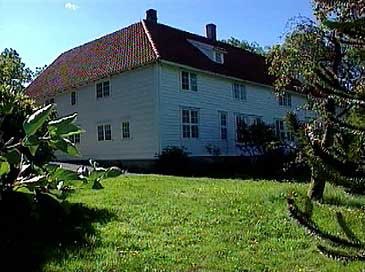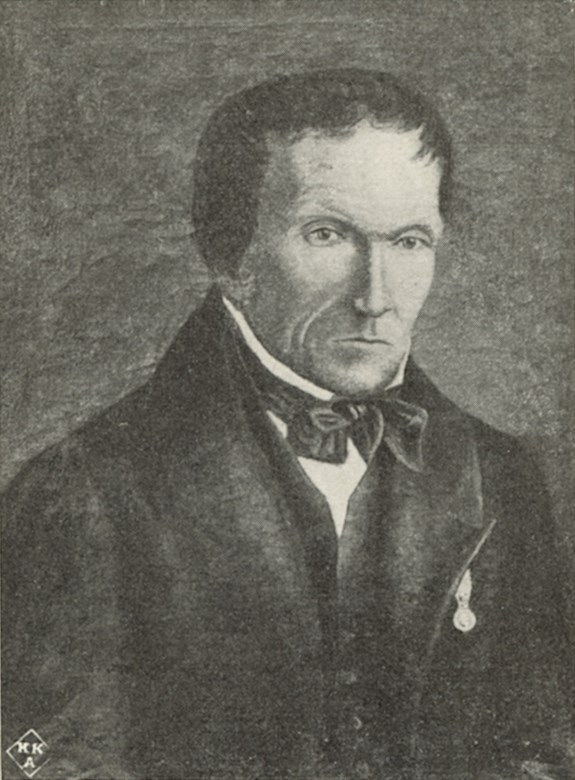In former times
Svanøy (Bru) is a sheltered and fertile island which was probably settled relatively early. It was easy for people to cultivate the soil there. The find of a greenstone axe dated back to the late Stone Age, and a buckle from the early Bronze Age are clear indications of early settlements. Other finds show that people lived of hunting, fishing, and agriculture. Some finds may indicate that there has been a pre-Christian cult site near the bay of Svanøybukta. The earliest Christian manifestation is the stone cross located on the old church site.
From diocese land to crown land
From "Bjørgvin Kalvskinn" - a cadastre or register showing the land property belonging to the Bergen diocese in 1350 - we know that the island had its own church and vicar in the 14th century. However, it is uncertain who lived there in the Middle Ages. In the late Middle Ages, Bru was diocese land under Bjørgvin (Bergen). After the Reformation, the king confiscated all the diocese lands. Between 1537 and 1661, Bru was crown land. The estate was then placed at the disposal of persons in the royal bureaucracy, for example bailiffs. The bailiff Hans Finsøn Rostvig is recorded as a tenant at Bru in 1667, but the first bailiff to settle down there was Lauritz Schiøtt who arrived in 1575. He was succeeded by two other bailiffs, Peder Due and Nils Busch. In 1642, the cavalry captain and nobleman Eskild Gøye took over the Bru estate, before the diocese secretary Anders Madsen was allowed to use Bru as his official residence in the late 1650s.
From Bru to Svanøy
In 1660, Frederik III introduced absolute monarchy in Denmark-Norway. He sold a number of the crown lands in the country. Several other properties in the Sunnfjord region belonged to the Bru estate. All these properties were sold all in one to the archbishop of Copenhagen, Hans Svane in 1662. The king was heavily indebted to the bishop, so the estate, which comprised 330 holdings and properties and 40% of the land register value in Sunnfjord, was used to reduce this debt. In 1666, Svane and his successors were granted tax exemption for the estate. Hans Svane died in 1668.
In 1685, his widow, Marie Fiuren, received a letter from King Kristian V to the effect that Bru was to be a privileged manor and a permanent nobleman's residence in line with the old noblemen's residences. The residents of the manor were to form a "birk" (judicial district), owned by Svane's heirs. The "birk" constituted a separate jurisdiction and administrative unit, where the lord of the manor could pass judgment and fine his tenant farmers if he thought that these had done something wrong. In western Norway, the Rosendal barony and the monasteries of Lysekloster and Halsnøy enjoyed the same "birk" privileges. In the same year (1685), the family was permitted to change the name to Svane Manor.
In 1692, Christen Hansen was a "birk" bailiff at Svanøy.
Nagel built a magnificent manor
The Svane family owned the manor for 56 years, but no family member ever lived there. The family let local bailiffs and managers run the estate. The county military officer Johan Sigismund de Lillienpalm bought the estate in 1718, but sold it shortly afterwards to the county secretary Severin Seehusen. At the same time he had inherited the Damsgaard manor in Bergen, but the latter had no noble privileges, which the Svane manor had. He changed his name to the noble name of Severin de Svanenhielm. His debts quickly ran into the enormous sum of 100 000 "riksdaler", and in 1724, the king mortgaged the estate. 340 holdings were sold individually at auctions, even the "birk" right was meant to be sold at an auction, but no-one was willing to pay the price asked.
The manor remained in the Svanenhielm family until 1749 when the "kammerråd" - a financial civil servant - and bailiff for Sunnfjord and Nordfjord, Hans Thiis Nagel, bought the Svane estate. For a while he owned 100 holdings in Sunnfjord. During the 20 years he was proprietor of the Svanøe manor, he developed the estate into one of the finest farms in western Norway. In addition to the elegant main residence, there were as many as 30 other buildings on the property, all in the vicinity of the main house and the church. His son, Jens Worm Nagel took over the Svanøy estate and the position as bailiff. He died childless in 1788, at the early age of 49. His widow, Christiane Margrete Nagel, remarried Herman Dietrich Janson, the owner of Damsgaard manor in Bergen.
The "birk" system ended
We do not know the names of all the "birk" judges at Svanøy. In the 1801 census, Henric Nitter is recorded as the manager of the estate, and he lived at Tysse in Fjaler (which was then the "Ytre Holmedal" parish). The "birk" judge Rennord lived on the farm called Svædene (now Sveen) in Gaular (then the "Indre Holmedal" parish). In 1805, Rennord was replaced by Nils Landmark as "birk" judge in the Svane "birk" (judicial district). In 1808, Landmark became the district recorder for Sunnfjord, and moved the following year to the farm of Tysse in Fjaler. There were still other "birk" judges before the system of the "birk" court was ended. With the Allodial Rights Act of 1 August, 1821, the system of "birk" courts was terminated, at the same time as all the titles of nobility in Norway were abolished.
The lay movement of Hans Nielsen Hauge took over
Janson settled down at Damsgaard and in 1804, he sold Svanøy to the lay preacher Hans Nielsen Hauge for 12 000 "riksdaler". Svanøy was thus transformed from a manor for a rich and powerful bailiff to a centre for Hauge's lay movement, whose followers - called the Haugianers - lived a god-fearing and unassuming life. Hauge let Ole Torjussen Helling run the farm. He and his wife, Kjersti, and other members of the lay movement turned Svanøy into a model farm. The Haugianers extended the farm in such a way that it became of use and help for people in the whole district. They introduced modern agricultural methods, and the farm became one of the biggest and best run farm in the district. They built their own mill to grind the corn, as well as their own saw mill to cut the timber felled on the property. They even built their own boatyard and with the timber material they built fishing boats. They needed salt, and naturally they built their own salt works. The salt works was built during the Napoleonic Wars, when the English introduced a trade embargo and all import to Norway was stopped.
Ole Torjussen Svanøe was a member of the Norwegian Storting (Parliament) from 1814 to 1842, and in 1821, he received the medal for civic service.


Port of call and post office
It has always been necessary to use a boat to get to Svanøy. In 1868, Svanøy was included in the schedules for the local steamship company of "Fylkesbaatane" on its regular service to Sunnfjord. The boat stopped at Kvalstad on the south side of the island. In the 1880s, the port of call was moved to the bay of Svanøybukt, first recorded in a schedule from 1887. Svanøybukt is still a port of call for the local express boats carrying both passengers and goods.
The post offices were frequently established where the steamers called, and this was also the case with Svanøy. On 15 November, 1870, the Kvalstad sub-post office was established and its first employee was Ole Andersen Kvalstad. In 1887, it changed its name to Svanø sub-post office, and in 1916 changed once more to Svanøbugten. The spelling was modernized to Svanøybukt five years later. However, in the 1990s, the Norwegian postal authorities started a process of closing down post offices and sub-post offices all over the country, and on 13 August, 1998, 6965 Svanøybukt terminated its services. As of 1 March, 1999, the correct postal address for the people of Svanøy is 6914 Svanøybukt.
Copper mine
In the 1860s, the Haugianers started extracting copper on the island. The owner Christoffer Svanøe then carried out trial operations lasting 18 months. Like his father, Christoffer Svanøe was also a pioneer in the field of agriculture. He, too, was a member of the Norwegian Parliament ("Stortinget") for a number of terms.
In the 1880s, under the ownership of Ole Svanøe, the mining operations got started in earnest, managed by a mining company in Bergen. For a while as many as 100 men could be working in the copper mine. In two periods up to about 1920, ore was extracted. When World War I broke out, the price of copper sank drastically, no longer making the operation profitable. Today we can see the entrances to the mines and heaps of slag after the operation.

The Svanøy Foundation
Bjarne Svanøe took over the farm after his father Ole. He ran the farm until he died in 1925, when his widow, Amalie, took over. In 1945, it was their son Kristoffer's turn to take over the farm. In November, 1972, Kristoffer Svanøy and his son Ole, made a deal with the Elkem managing director Christian Sommerfeldt in which the Svanøy Foundation would get hold of the main farm and the surrounding buildings and areas, on the condition that two million kroner could be raised. 45 persons showed interest in the foundation, later on this number has increased to 65. Each of the first 45 founders contributed 100 000 kroner, totalling 4.5 million kroner. Most of the founders were businesses and persons within shipping, industry, and banking. Later on, another 4.5 million kroner was raised, thus making the total sum nine million.
The purpose of the Svanøy Foundation was to restore the main buildings, but also to make Svanøy a stimulating centre for new activities, in accordance with Svanøy's long, interesting, and honourable history. The Foundation embarked on the restoration of the magnificent main residence which had been listed since 1924. At the same time, an aquaculture facility for salmon and trout was established on the island of Langøya to the west of Svanøy. This was in fact one of the first fish-farming installations in the country. The Foundation also bought the farm Kvalstad to be used for various projects and activities. All these activities were managed by the chairman of the board of directors Christian Sommerfeldt and Harald Skjervold, chairman of a consultative council. Ole Svanøe became the first manager.
Increased activity
Since the Svanøy Foundation started its project, other businesses and activities have been introduced on the island, such as in aquaculture and production facilities for salmon, tourism, trade, and food services. There is still a boatyard on the island, thus keeping up this traditional activity. In addition, there is a new waterworks, new roads and conference facilities have been built, and the population has increased. The farms on Svanøy have launched several activities for children as well as grown-ups. At Erikstad, where Eirik Blood-Axe was said to have been raised, people can learn to ride. The Kvalstad farm is the location of the Norwegian Deer Centre which is a national centre for knowledge dissemination as well as research and development concerning game deer and domesticated deer. Fallow deer are also found there, besides the more common Norwegian deer.
The Svanøe family, Ole Svanøe and his wife Eva, moved out of the old main residence in 1963, now living in an ordinary house on the farm. They look upon themselves as farmers, and when their son, Bård Kristoffer, will take over the farm in some years, he will be the seventh generation since Ole Torjussen Helling came here in 1804 and started as a farmer on the island of Svanøy.







